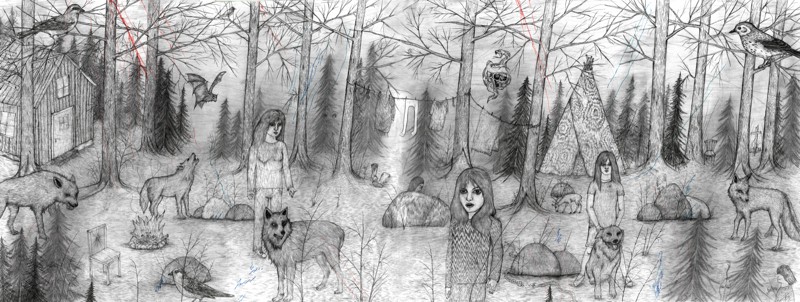 |
| Ragnar Persson, När Mörkret Faller, 2011, image: Gallery Steinsland Berliner |
In Ragnar Persson’s När Mörkret Faller/When Darkness Falls, 2011, the artist devises a roaming pack of wild dogs or wolves alongside an equally untamed coterie of human beings—long-haired, solitary, holding piercing gazes—in a northern forest populated with somewhat secretive animals: falcons, snakes and nocturnal creatures. The scene is also randomly littered with red lightning bolts scratched into view, a teepee, empty wooden chairs and leafless trees indicating autumn or early spring. But: why is this highlighted scene important to someone who is not a part of it? Why are the individuals turned towards the viewer in this confrontational manner? What do these entities expect or desire from those who watch them, and what will become of this view? A view which appears to be waiting for the unexpected; it stands to want from the outside or unknown.
Persson’s appeal may be the fact that each of his framed drawings is a snapshot into a more distinctive narrative that one hopes to be either directly a part of or allowed to gaze upon as a voyeur. Persson embraces an experimental, fantastical quality; this searching trait can be found in the visages of the spectral characters present in his work. They either look directly at the viewer—glassy-eyed, vapid or in contrast, intense—or they stare past the viewer and off into a peripheral netherland. Persson often limits himself to black & white or charcoal shades, choosing to add color when an absolute necessity. The decision seems indicative of Persson’s overall creative approach: to make out of raw necessity is more genuine than to make for other reasons. The artist emphasizes an alternative spiritualism with occultish threads of influence, and the rapport between and among animals and people in his images are finely orchestrated. His characters can seem to be pensive, modern-day pastoral philosophers possessing ideas worth unraveling. Relationships between present characters in När Mörkret Faller/When Darkness Falls may at first be off-putting, yet on second glance, they appear friendly in that way an unexpected stranger becomes after you abandon reserve.To see the review in context, click here.








